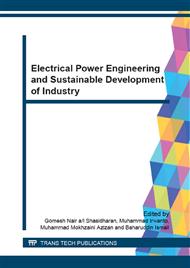p.242
p.247
p.252
p.257
p.262
p.267
p.274
p.280
p.286
Effects of Different Voltage Sag Types on Induction Motor
Abstract:
This paper analyzes effects caused by voltage sag types A, B, C and D on induction motor based on experimental test. The effect can be investigated in term the current peaks and speed variation. The magnitudes depend on magnitude of sag and duration, voltage sag types, during and recovery voltage sag. Several of voltage sag characteristics have been conducted in different magnitude, duration and sag types. The results show that the current peaks generated reach more than 4 times of normal current and it was achieved at recovery voltage instant. Sag magnitude has great influence on the current peak but sag duration is not significantly. Type A voltage sag only can cause the motor stop running and it was achieved when it was subjected to sag magnitude of 10% and 6s in duration. The motor stops running in shorter duration when it was subjected to interruption with sag duration of 4s. Therefore voltage sag of type A lead to more severe on induction motor if compared with other sag type. This is according to number of phase that experience sag. The magnitude and duration of voltage sags have influenced significantly on the motor speed only for low sag magnitude and long sag duration.
Info:
Periodical:
Pages:
262-266
Citation:
Online since:
September 2015
Keywords:
Price:
Сopyright:
© 2015 Trans Tech Publications Ltd. All Rights Reserved
Share:
Citation:


